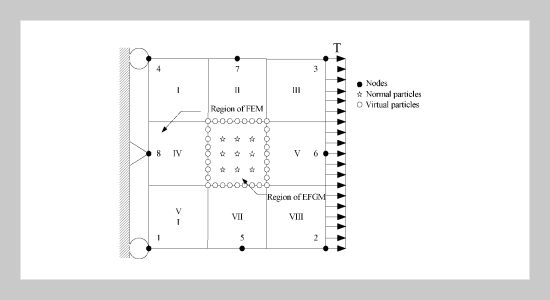REFERENCES
- [1] Belytschko, T., Lu, Y. Y. and Gu, L., “Element-Free Galerkin Methods,” International Journal for Numerical Methods in Engineering, Vol. 37, pp. 229�256 (1994).
- [2] Belytschko, T., Organ, D. and Krongauz, Y., “A Coupled Finite Element-Element Free Galerkin Method,” Computational Mechanics, Vol. 17, pp. 186�195 (1995).
- [3] Hegen, D., “Element-free Galerkin Methods in Combination with Finite Element Approaches,” Computer Methods in Applied Mechanics Engineering, Vol. 135, pp. 143�166 (1996).
- [4] Rao, B. N. and Rahman, S., “A Coupled MeshlessFinite Element Method for Fracture Analysis ofCracks,” International Journal of Pressure Vessels and Piping, Vol. 78, pp. 647�657 (2001).
- [5] Ho, S. L., Yang, S., Ni, G., Wong, H. C and Wang, Y., “Numerical Analysis of Thin Skin Depths of 3-D Eddy-Current Problems Using a Combination of Finite Element and Meshless Methods,” IEEE Transactions on Magnetics, Vol. 40, pp. 1354�1357 (2004).
- [6] Huerta, A. and Fernandez-Mendex, S., “Enrichment and Coupling of the Finite Element and Meshless Methods,” International Journal for Numerical Methods in Engineering, Vol. 48, pp. 1615�1636 (2000).
- [7] Lu, Y. Y., Belytschko, T. and Gu, L., “A New Implementation of the Element Free Galerkin Method,” Computer Methods in Applied Mechanics Engineering, Vol. 113, pp. 397�414 (1994).
- [8] Belytschko, T., Lu, Y. Y. and Gu, L., “Crack Propagation by Element-Free Galerkin Methods,” Engineering Fracture Mechanics, Vol. 51, pp. 295�315 (1995).
- [9] Krysl, P. and Belytschko, T., “Analysis of Thin Plates by the Element-Free Galerkin Methods,” Computational Mechanics, Vol. 17, pp. 26�35 (1995).
- [10] Fleming, M., Chu, Y. A., Moran, B. and Belytschko, T., “Enriched Element-Free Galerkin Methods for Crack Tip Fields,” International Journal for Numerical Methods in Engineering, Vol. 40, pp. 1483�1504 (1997).
- [11] Krongauz, Y. and Belytschko, T., “Enforcement of Essential Boundary Condition in Meshless Approximation Using Finite Elements,” Computer Methods in Applied Mechanics Engineering, Vol. 131, pp. 133� 145 (1996).
- [12] Zhu, T. and Atluri, S. N., “A Modified Collocation Method and a Penalty Formulation for Enforcing the Essential Boundary Conditions in the Element Free Galerkin Method,” Computational Mechanics, Vol. 21, pp. 211�222 (1998).
- [13] Mukherjee, Y. X. and Mukherjee, S., “On Boundary Conditions in the Element-Free Galerkin Method,” Computational Mechanics, Vol. 19, pp. 264�270 (1997).
- [14] Gavete, L., Benito, J. J., Falcon, S. and Ruiz, A., “Implementation of Essential Boundary Conditions in a Meshless Method,” Communications in Numerical Methods in Engineering, Vol. 16, pp. 409�421 (2000).
- [15] Fernandez-Mendez, S. and Huerta, A., “Imposing Essential Boundary Conditions in Mesh-free Methods,” Computer Methods in Applied Mechanics Engineering, Vol. 193, pp. 1257�1275 (2004).
- [16] Lee, S. H. and Yoon, Y. C., “Numerical Prediction of Crack Propagation by an Enhanced Element-Free Galerkin Method,” Nuclear Engineering and Design, Vol. 227, pp. 257�271 (2004).
- [17] Gu, Y. T. and Liu, G. R., “A Coupled Element Eree Galerkin/Boundary Element Method for Stress Analysis of Two-Dimension Solids,” Computer Methods in Applied Mechanics Engineering, Vol. 190, pp. 4405� 4419 (2001).
- [18] Rao, B. N. and Rahman, S., “An Enriched Meshless Method for Non-Linear Fracture Mechanics,” International Journal for Numerical Methods in Engineering, Vol. 59, pp. 197�223 (2004).
- [19] Cook, R. D., Malkus, D. S. and Plesha, M. E., Concepts and Applications of Finite Element Analysis, Third edition, John Wiley & Sons, New York (1989).
- [20] Timoshenko, S. P. and Goodier, J. N., Theory of Elasticity, Third edition, McGraw-Hill, New York (1986).
















